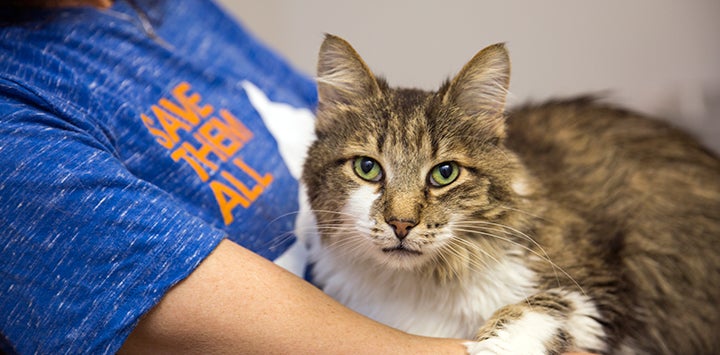
Reduced Fee Adoptions: Why They Work
The jury is in. Reduced-fee and no-fee adoptions save lives. Lower adoption prices help shelters and rescue groups to:
- Quickly find homes for more animals
- Find homes faster for hard-to-place pets like senior pets, pets with special needs, etc.
- Increase save rates at shelters with open-admissions
- Attract new adopters and allow previous adopters to adopt additional pets at a lower cost
Do you have supporters, donors, board members or volunteers with concerns?
No problem. There have been many studies and reports that prove reduced-fee and low-fee adoptions work.
- Maddie’s Fund did a post-adoption survey of its sponsored adoption event in San Francisco in 2011, which offered free adoption fees. The upshot? Six to 12 months after the event, 95 percent of dogs and 93 percent of cats were still in their original forever homes. That means the return rate was actually less than average for most shelters and rescue groups. To see other results from the study, please see the summary of the the Maddie’s Fund study here.
- With a good, conversation-based adoption process in place, along with a short application, people who want animals for less-than-honorable purposes are not likely to try and adopt because they don’t want their actions to be documented by virtual or paper trails. That means, no matter what the adoption fee, as long as you have an effective adoption process, you can attract quality adopters.
- The ability of adopters to pay high adoption fees does not guarantee the quality of their homes or their future ability to support adopted pets. It also doesn’t ensure that pets will not be returned or given to another person. Everyone loves a deal, regardless of income.
- According to a study published in the Journal of Applied Animal Welfare Science, people who adopted cats with waived fees had the same degree of attachment as those who paid fees. Additionally, the study found that eliminating fees did not devalue the cats in the eyes of the adopters.
- The longer animals stay in a shelter, the more likely it is that they may develop health and behavioral problems, which costs money to treat. That means reduced and no-fee adoptions may save your organization money because, the faster you find pets homes, the less you will spend on their care. Plus, the faster you help animals find homes, the happier and healthier they’ll be and the more lives you’ll be able to save.
Are you worried about losing revenue?
Consider the thoughts of Bonney Brown, president of the Humane Network, who says: “This idea that we are funded with fees is a business model that never worked. If we were only fee-based, the IRS would not allow us to be nonprofits. The government, in a sense, is acknowledging that we cannot operate solely on fees — hence the allowance for tax deductible donations.”
The Cat Adoption Team in Oregon also found that reducing adoption fees doesn’t mean less revenue. Karen Greene, executive director, summed up the results of a 2013 adoption promotion, where fees were significantly reduced for both adult cats and kittens. Her organization experienced an 89 percent increase in the number of cats and kittens adopted, compared with the previous year when no discounts were offered. Plus, total adoption revenue was up 63 percent! So, although the average revenue per cat was down, total revenue was up.
Both Bonney and Karen believe that donations should be a big priority. Karen said that in 2014, the Cat Adoption Team went to a “100 percent ask” policy in the adoption process — meaning that all adopters are asked if they would care to make a donation to support the organization. How did they do it? Adoption counselors were trained, and then they rehearsed their pitches. Cards for the adoption tables served as reminders. And they created a check box on the adoption application for counselors to initial once they made the request. According to Karen, “The number one reason people give for not donating to a charity with which they’ve had an interaction is that they weren’t asked.” She explained that staff and volunteers developed their own style and it quickly became part of their everyday routine.
Ready to be flexible on fees and save more lives? Here are a few tips to help you get started:
- Meet with your stakeholders and make sure your board members, staff and volunteers understand why reduced and no-fee adoptions are so important. Then identify other possible sources of revenue.
- Do you have a thrift store or sell collateral merchandise such as pet supplies? Be ready to promote those to your maximum ability. The Cat Adoption Team found that merchandise sales increased as adoptions increased.
- Create a donation program, and be sure to invite every adopter or visitor to your facility, website and social media page. Make sure that your donation information is prominently displayed. Try not to make people hunt for a donation button on your website or Facebook. Get it on every page and coach your staff.
- Apply for grants. A good list of organizations that grant money to shelters and rescue groups can be found here.
- Check with your local community foundations and find out if they will consider grants to your organization. Search for foundations here. Search for foundations at the Community Foundation Locator.
- Seek business and corporate donations. Identify the major economic drivers in your community, and don’t be afraid to approach them. Connect with local civic groups and church organizations, and solicit their help. Also consider reaching out to donors to sponsor adoption fees for certain animals or kennels.
- Raise awareness of your organization through your increased adoption numbers and low and no-cost promotions. Many organizations have trouble “catching the eye” of the media for coverage. And these promotions, as well as your increased adoption numbers, will give them a good story “hook.” That should generate future donors, volunteers and other resources, as well as support.
- Create or grow a planned giving program. These plans enable donors to make sustaining gifts either during their lives or from their estates. A great how-to resource is available from the Association of Fundraising Professionals.
- Consider a consultation with a nonprofit fundraising professional. It’s good to have a set of objective eyes review your organization’s fundraising strategy and make suggestions based on your size and capabilities.
Reduced adoption fees save lives. Consider what happened when Animal Outreach of Shelby County in Indiana lowered fees. Kerry Ann May, president of the organization, said, “Our cats were being adopted so darn quickly, we were able to pull cats from the municipal shelter more often. This resulted in a nearly 10-fold increase in pulls from the shelter in one year!”
And that is how, together, we can Save Them All®!
 Adoption Barrier Study & Solutions
Adoption Barrier Study & Solutions Client Service & Open Adoptions Course
Client Service & Open Adoptions Course Adoptions Training Playbooks
Adoptions Training Playbooks